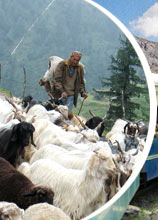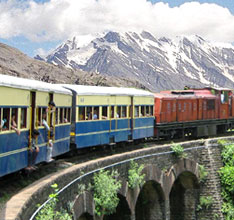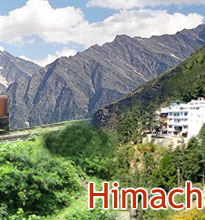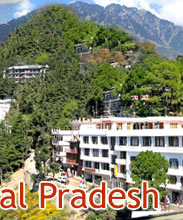 Kangra Fort was once the stronghold and seat of power of Katoch rulers,
who ruled the land for over 2000 years. Today, it stands in ruins
because of the devastating earthquake that hit the area in 1905. The
location of the fort is such that it is inaccessible from three sides.
Kangra Fort of Himachal Pradesh overlooks the rivers of Manjhi (or Patal
Ganga) and Ban Ganga. This massive fort once housed the royal residences
and shrines in its highest part. All that is left intact now are its
surrounding battlements, the temple of Goddess Ambika Devi and two Jain
temples.
Kangra Fort was once the stronghold and seat of power of Katoch rulers,
who ruled the land for over 2000 years. Today, it stands in ruins
because of the devastating earthquake that hit the area in 1905. The
location of the fort is such that it is inaccessible from three sides.
Kangra Fort of Himachal Pradesh overlooks the rivers of Manjhi (or Patal
Ganga) and Ban Ganga. This massive fort once housed the royal residences
and shrines in its highest part. All that is left intact now are its
surrounding battlements, the temple of Goddess Ambika Devi and two Jain
temples.One of these Jain temples is dedicated to Tirthankar Adinath and is believed to be built in 1466, under the reign of Raja Sansar Chand I. According to the folklore, Raja Susharma Chandra built the fort in the old Kangra town just after the Mahabharata war. The earliest remnants of Kangra Fort are the Jain and Brahmanical temples that belong to 9th century. The fort has faced invasion of Mahmud Ghazni in 1009, was captured by Muhammad Tughlaq in 1337 and faced seizure by Firoz Shah Tughlaq in 1351 AD. It escaped the clutches of Mughal invaders until 1621, when Emperor Jehangir conquered it.
Finally in 1786, Raja Sansar Chand II succeeded in recovering the ancient fortress of his ancestors. However, he had to face constant conflicts with Amar Singh Thapa, leading the Gurkhas, and Sikh ruler, Maharaja Ranjit Singh. Sikhs conquered the fort in 1809, until British wrested it from them in 1846. The main entrance of the Kangra Fort is known as the Ranjit Singh Gate, which leads down a path to the Jehangir gate through the Ahani and Amiri Darwaza. The road to the left leads to Darsani Darwaza, with two deformed statues on its sides that are believed to be of Goddesses of River Ganga and River Yamuna.
This road leads to the 9th century temples of Lakshmi Narayan Temple and Shitala Mata and the recently built temple of Goddess Ambika Devi. A staircase leads one to Shish Mahal and the polygonal watchtower. The road to the right leads to the 'Mihrab' or minaret of a Jehangiri mosque, the Kapoor Sagar tank and other structures. A sculpture shed was also found in the fort, with a number of loose sculptures and architectural elements. Out of these, the six most important ones can be seen at the Himachal State Museum in Shimla. Kangra Fort is a protected monument, managed by the Archeological Survey of India.









